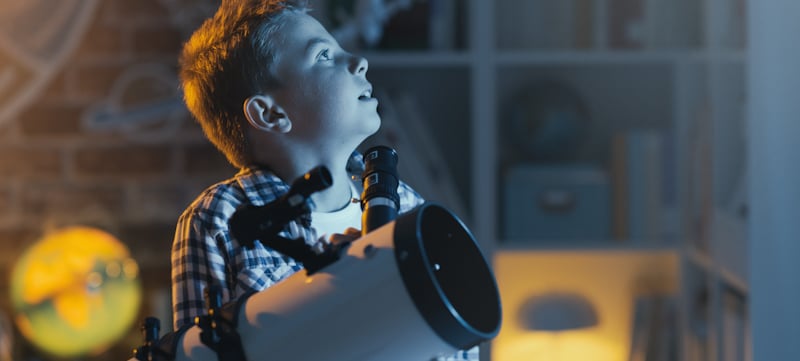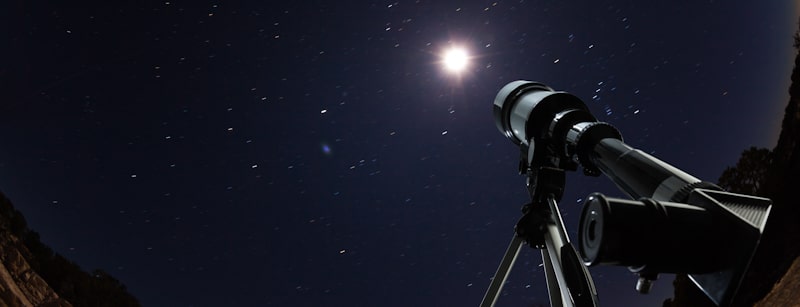When you obtain your first telescope, it is an exhilarating day. You are probably eager to try it out, and you may have already done so but had a bad experience. That is because, while it is exciting to be able to study the galaxy with your telescope, it is a little more involved than simply pointing at it and praying for the best.
The first step to using a telescope is to assemble it according to the direction in the user's guide. Then get a star guide; this will assist you in identifying items via your telescope. Next, get a good location for observation; make sure you have unrestricted access to the sky.
Before you attempt to use a telescope as a beginner, it is necessary that you know all about your telescope. You should know the function of each part and its accessories; it would be easier to understand how to use the telescope.
 Beginners Guide To Telescopes
Beginners Guide To Telescopes
As a beginner, you should not just jump into using your telescope. You should follow some guides to ensure you fully understand how to use a telescope and have a good time while you are at it. Below are the beginners' guides to telescopes.
Get A Star Guide
When you first obtain your first telescope, it is tempting to go out and try it out as quickly as possible. While this is entertaining for a while, astronomers like the challenge of discovering precise targets with their telescopes. You can pinpoint a few objects with the naked eye, such as some planets and the moon, but it will not be long before you are looking for dimmer things.
That is why a star guide can help; it does not only assist you in identifying items that you cannot identify with your human eye but can with your telescope. It can also assist you in tracking down new things to gaze at, which might become more intriguing with a better view. Finally, a star guide will inform you exactly what you are looking at when you see something.
A star guide would provide you with all of the information you require. Although you may still buy a real star guide like a book or magazine, most astronomers nowadays prefer to use applications on their mobile devices. These applications provide most of the same valuable information; however, they also pinpoint your position and provide results suited to your precise area.
Find A Place To Observe
You will need to choose a location to view once you have received your telescope and star guide. When looking for the optimal location, the most important thing is little light pollution and unrestricted access to the sky. If you live in a neighborhood or urban area with lamps on every corner, you may need to drive a little beyond your backyard.
As much as you can go stargazing in such areas, you will have difficulty finding many of the fainter objects. Locating a location with unrestricted access to the sky is even more crucial than finding a location with reduced numbers of light pollution. Even trees can create an obstruction; therefore, the center of a park or field is excellent.
Accessories To Consider
After getting your telescope, star guide, and the right spot to watch, there are a few items you should think about. Although none of these extras are needed, they can help make your outing go more smoothly. You have to have a visual when arranging your telescope, but white lights force your eyes to adjust, limiting what you see when looking at the sky; red lights have a different effect.
Red flashlights in a telescope give you the perfect combination by allowing you to see without adjusting your eyes to brighter settings. It is inexpensive and well worth purchasing to make your trip more pleasant. If condensation forms on your glasses or mirrors, moisture might ruin your outing; a dew shield is among the simplest ways to avoid this problem from arising.
Using A Telescope
These are the procedures you will need to perform to find the entities you seek in the sky once you have gathered all of your equipment and are prepared to set out for the night. If you have never assembled a telescope previously, you must do so first inside your home. Even if you have to disassemble everything later, putting it together now would make it much easier when you are outside at night.
Level Your Tripod
Ensure your tripod is level prior to when you begin narrowing down anything. Whether or not you will need to have a level surface depends upon your tripod, but starting with one will make things much easier once you begin looking for objects and making changes to your telescope.
Orient Your Telescope
Although motorized telescopes might help you discover objects and make the whole observational experience easier, if you do not properly align them, you will not know where it is or how to find multiple celestial objects. Locate the polar north and aim your telescope in that position.
Following that, you must follow the specific instructions for your telescope.
Adjust Your Finder
Once you have focused on your target, you will only need to make minor tweaks, provided your finder is properly tuned. However, you must first align your finder with your telescope before using it; this may appear not easy, but it is rather simple. Aim it at the clearest item in the celestial sphere, which is usually the moon.
After that, use your telescope to center the object you are aiming for. You can begin your observation session once the object is in the middle of your telescope and finder.
Using Your Finder
This is among the most crucial phases in learning about using your telescope. There are two sorts of finders included with your telescope: a red dot finder and an optical finder. Red dot finders do not have any magnification, so you have to look into them and coordinate the red dot with the region you want to examine.
Optical finders are miniature telescopes that attach to the main telescope's top. They have lower magnification and a larger field of vision, allowing you to pinpoint your target before switching to the primary scope.
Begin With Low Magnification
Begin with the lowest magnification even when you have zeroed in on your subject with the finder. You will need to change your focus as your magnification increases to see what you are viewing clearly. It may seem apparent, but you must refocus your telescope
each time you raise your magnification.
 How To Look Through A Telescope
How To Look Through A Telescope
As indicated in the instruction, the first thing to do is to mount the finder and finder bracket on your telescope. Select the least magnification eyepiece you have and place it in your focuser. During the day, bring your telescope outside and position it so that you can see a fixed object that is a long way away.
Manually aim your telescope towards the object as well as possible, then peer through the eyepiece. When peering through your telescope finder, utilize the adjustment knobs to position your target accurately in the visual field. Switch your eyepiece to another greatest magnification while keeping your telescope locked down.
Final Thoughts
Few things can compare to the thrill of seeing the earth via a telescope for the very first time. If you do not understand what you are doing, your joy can rapidly become a frustration. The excellent thing is that learning to use a telescope is not difficult with some homework and planning. However, ensure that you do not attempt to use your telescope on the sun as a beginner, as it might seriously affect your eyesight.
Also read:
Shawn Manaher loves to play with new toys and dive into new hobbies. As a serial entrepreneur, work definitely comes first but there is always room for hobbies.

![How to Use a Telescope for Beginners [COMPLETE GUIDE]](https://hobbynation.net/wp-content/uploads/2022/05/how-to-use-a-telescope-720x405.jpg)
 Beginners Guide To Telescopes
Beginners Guide To Telescopes How To Look Through A Telescope
How To Look Through A Telescope